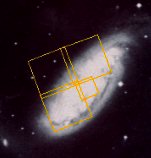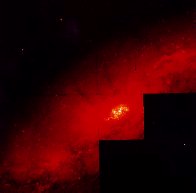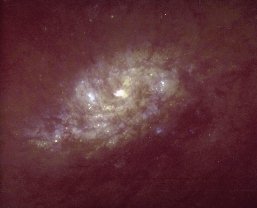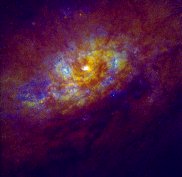
| The peculiar barred spiral galaxy NGC 1808 as it appears in the Digitized
(Palomar) Sky Survey, with the WFPC2 field-of-view overlayed. The galaxy is about
40 million light years away in the southern constellation of Columba. The outer
arms of the galaxy are warped with respect to the prominent inner dust lanes.
This is evidence that NGC 1808 may have had a tidal interaction with the nearby galaxy
NGC 1792, which may have triggered the circumnuclear starburst activity seen in the
Hubble images. |
| Mosaicked broad band R image of NGC 1808. Multiple star clusters are visible
amid dense gas and dust. Filaments of dust can be seen streaming from the starburst
region along the minor axis of the galaxy and into the galactic halo. The portion
of the galaxy seen here is about 35,000 light years across. |
 |
 |
Narrow band [NII - Singly ionized Nitrogen] emission image of NGC 1808. Notice the star formation triggered
in the galactic bar, as matter streams toward the nucleus to feed the starburst. |
| High-resolution view (just the PC1 camera) of the starburst activity in the
circumnuclear region. Many compact star clusters are revealed, but many more are
probably obscured by the thick spiralling lanes of gas and dust. The brightest
knot of star formation seen here is probably a giant cluster of stars at the very
center of the galaxy. The starburst region shown here is about 3,000
light years across. |
 |
 |
False color image of the high-resolution view above
showing enhanced details. |